Living in Boulder, Colorado means having the extraordinary privilege of being surrounded by some of the most breathtaking mountain scenery in America. From the iconic Flatirons’ dramatic slabs to the sweeping panoramas of the Front Range, these natural backdrops aren’t just pretty pictures—they’re transformative elements that can fundamentally enhance our living spaces and daily experiences.
As someone who’s spent years helping homeowners make the most of Boulder’s incredible vistas, I’ve learned that thoughtfully integrating mountain views into home design isn’t just about aesthetics—it’s about creating spaces that nourish the soul while simultaneously boosting property value. In this guide, I’ll walk you through everything you need to know about maximizing those magnificent mountain views in your Boulder home.
When you wake up to sunlight dancing across the Flatirons or unwind with a glass of wine as alpenglow paints the Front Range, something magical happens. The mountain views that define Boulder’s landscape aren’t just stunning backdrops—they become dynamic living elements that transform your home experience throughout the day and across seasons.
How Mountain Views Transform Your Living Experience
Living with mountain views creates a profound connection to nature that changes your relationship with home. Imagine starting your day with coffee as morning light illuminates the Flatirons, working from a sun-filled office with the mountains as your inspiration, or hosting friends on a deck where conversation naturally pauses to appreciate a spectacular sunset over the peaks.
These daily moments add up to something significant—a home that feels bigger than its square footage, more peaceful than its address might suggest, and more connected to Boulder’s natural beauty. Research consistently shows that access to natural views reduces stress, improves mood, and enhances overall well-being. In Boulder’s fast-paced tech and academic environment, having that visual escape can be particularly valuable.
“The connection to nature that mountain views provide isn’t just a luxury—it’s becoming essential to many Boulder residents’ sense of place and well-being,” notes Michael Donohue of Stillwater Architecture, a prominent Boulder-based firm specializing in view-optimized homes. “People are seeking that indoor-outdoor connection more than ever before.”
The Real Value of Mountain Views in Boulder’s Housing Market
Beyond the emotional and lifestyle benefits, mountain views represent significant financial value in Boulder’s competitive real estate market. According to recent data from local appraisers and real estate professionals, homes with well-designed mountain views can command premiums of 15-30% compared to similar properties without views.
In 2025’s home market, properties with premium Flatirons or mountain range views continue to outperform the market. Several factors contribute to this resilience:
- Scarcity: Boulder’s building regulations, including height restrictions and the historic “Blue Line” that limits development on the mountain backdrop, create inherent scarcity for mountain view properties.
- Emotional appeal: Buyers often make decisions based on emotional connections, and few features create stronger first impressions than walking into a home and being greeted by a stunning mountain vista.
- Year-round enjoyment: Unlike some home features that might be seasonal (like swimming pools), mountain views provide enjoyment in every season, from snow-capped winter peaks to vibrant fall colors.
- Perceived space: Homes with expansive views feel larger and more open, even with modest square footage.
As one longtime Boulder real estate professional put it:
“I’ve never had a client regret paying more for a mountain view. I have, however, had clients regret compromising on views to save money.”
Selecting the Perfect Site for Maximum Mountain Views
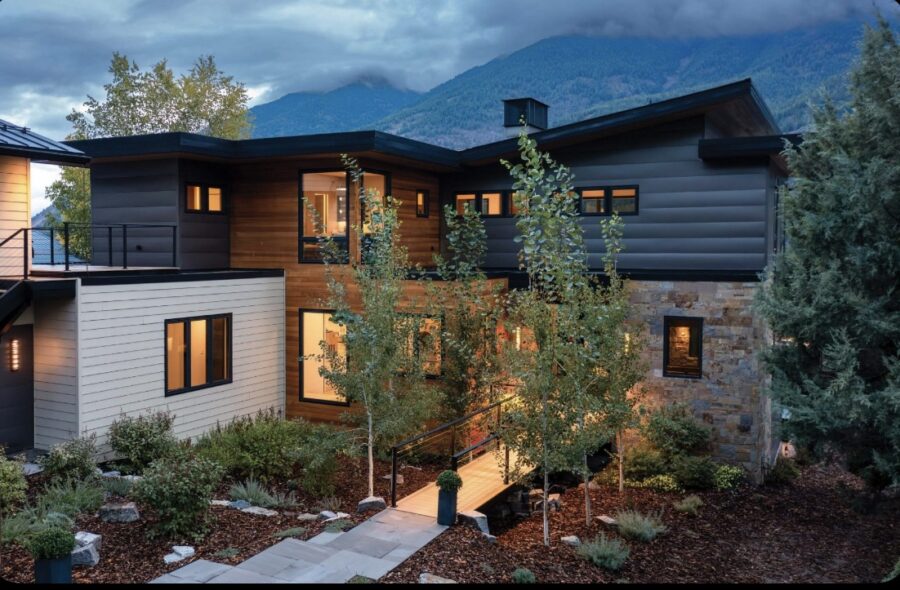
The journey to a mountain view home begins long before construction—it starts with finding the right piece of Boulder. Location, orientation, and understanding local regulations all play crucial roles in maximizing your views.
What Site Features Enhance Mountain Views?
Not all Boulder sites are created equal when it comes to view potential. The ideal property for mountain views typically features several key characteristics:
Elevation changes provide natural advantages, with gentle south or west-facing slopes offering optimal viewing platforms. These slightly elevated positions allow your home to capture panoramic vistas across the landscape without requiring excessive height that might run afoul of Boulder’s strict building codes.
Mature trees can be both assets and obstacles. While they add privacy and natural beauty, strategic placement and occasional trimming may be necessary to frame rather than block mountain views. Working with an arborist who understands view preservation can help strike the right balance.
The surrounding neighborhood context matters tremendously. Boulder’s commitment to view preservation means that understanding what can be built around you is essential. Areas with established view corridors or properties bordering protected open space offer more certainty about future view protection.
Corner lots or properties at the end of cul-de-sacs often provide wider viewing angles that can be maximized through thoughtful architectural design. These premium positions typically command higher prices but offer significant advantages for view optimization.
When evaluating potential sites, consider visiting at different times of day to understand how changing light conditions affect the views. What looks spectacular at sunset might be less impressive in morning light, and seasonal changes can dramatically alter viewscapes as foliage changes or disappears.
The Critical Importance of Site Orientation
In Boulder, orientation isn’t just about cardinal directions—it’s about aligning your home with specific mountain features. While western and southwestern exposures generally capture the most dramatic Front Range panoramas, each neighborhood offers unique viewing opportunities.
For Flatirons’ views, south-facing sites often provide the most iconic vistas of Boulder’s signature rock formations. Properties in north Boulder or south Boulder with western exposures can capture sweeping views of the Continental Divide, while elevated positions in east Boulder sometimes offer surprising mountain panoramas above the city.
The sun’s path significantly impacts how mountain views are experienced throughout the day. Morning light illuminating the Flatirons creates a dramatically different effect than afternoon sunlight on the peaks or the golden hour before sunset. Working with an architect familiar with Boulder’s specific light conditions can help maximize these changing dynamics.
Smart orientation also accounts for seasonal changes. Winter snow on the peaks creates stunning visual contrast, while summer thunderstorms can produce dramatic light against the mountains. Understanding these cycles helps position your home to capture the full range of Boulder’s mountain moods.
Navigating Boulder’s View Preservation Regulations
Boulder takes mountain views seriously—so seriously that the city has enacted various regulations specifically designed to protect them. Understanding these rules is essential before embarking on any view-focused design project.
The city’s height restrictions, typically capped at 35 feet in most residential zones, exist primarily to preserve neighborhood views and solar access. These limitations require creative architectural solutions rather than simply building upward to capture views.
Boulder’s historic “Blue Line,” established in 1959, restricts city water service above certain elevations (typically 5,750 feet) to protect the mountain backdrop from development. This visionary early conservation measure continues to shape Boulder’s viewscapes today.
Neighborhood-specific design guidelines may contain additional view preservation measures. For example, certain planned communities in North Boulder and along the foothills have explicit rules about roof heights, tree placement, and building massing to maintain view corridors.
Solar access ordinances, while primarily focused on ensuring homes receive adequate sunlight, also indirectly protect views by limiting how much a neighbor’s additions or new construction can block existing sightlines.
Working with an architect and contractor familiar with Boulder’s unique regulatory environment can help navigate these complexities while still achieving your view-related goals. As one local architect noted,
“The constraints often lead to more creative solutions that end up enhancing rather than limiting the connection to the mountains.”
Architectural Features That Amplify Mountain Views
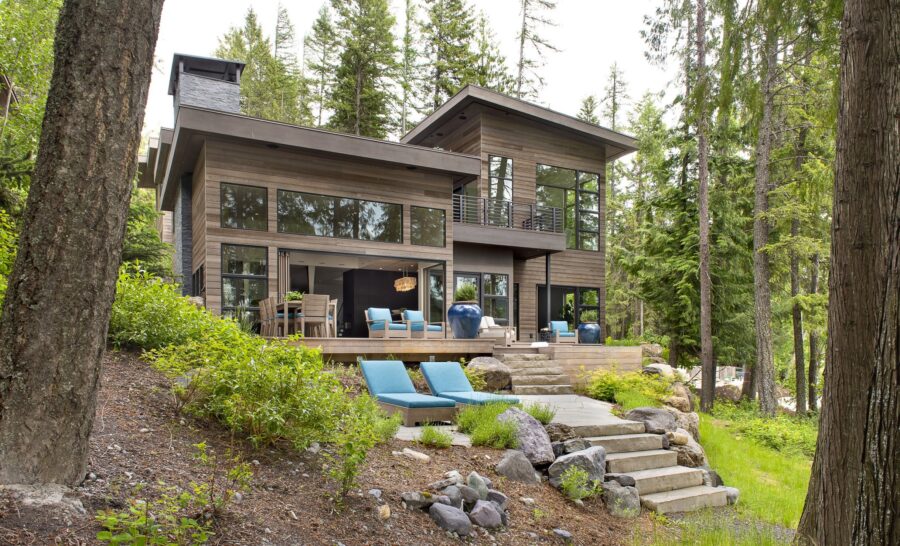
Certain architectural elements have proven particularly effective at maximizing Boulder’s mountain views:
- Expansive decks and terraces create seamless indoor-outdoor transitions that extend living spaces toward the views. Strategically positioned outdoor spaces can serve as natural viewing platforms, especially when designed with low-profile railings or glass barriers that won’t obstruct sightlines.
- Deep roof eaves and overhangs provide crucial protection from Boulder’s intense sunlight without compromising views. These elements create comfortable transition zones between indoors and outdoors while framing mountain vistas like natural picture frames.
- Cantilevered structures dramatically extend living spaces toward views, creating the sensation of floating above the landscape. These architectural features require sophisticated engineering but can produce spectacular results, particularly on sloped sites where they can project toward distant mountains.
- Clerestory windows introduce light from unexpected angles, creating interesting interplays between mountain views and interior spaces. When used in combination with lower view windows, they can flood spaces with natural light while maintaining privacy from neighboring properties.
- Corner glass installations where two glass panes meet without a structural column creates uninterrupted panoramic views that can span 180 degrees or more. These striking elements have become more accessible as glass technology has advanced, though they require careful engineering and precise installation.
Modern vs. Rustic: Which Style Better Frames Boulder’s Mountains?
Boulder’s architectural landscape continues to evolve, with mountain modern designs gaining significant popularity in recent years. This style combines clean contemporary lines and generous glazing with natural materials that reference the surrounding landscape.
According to Robert Gilbert, a Colorado architect specializing in mountain homes,
“Contemporary design continues to dominate. Clients want unique and different modern and contemporary designs that will stand the test of time.”
This trend embraces the dramatic contrast between crisp architectural forms and the rugged natural backdrop of the mountains.
The mountain modern approach typically features:
- Simplified forms with flat or low-pitched roofs
- Extensive use of glass, often in floor-to-ceiling installations
- A restrained palette of natural materials like stone, wood, and metal
- Clean lines and minimal ornamentation
- Thoughtful integration with the surrounding landscape
However, more traditional rustic-luxury styles also maintain strong appeal, particularly in neighborhoods where historical context is valued. These designs typically incorporate:
- Pitched roofs that echo mountain forms
- Substantial natural materials with textural emphasis
- Covered porches and protected outdoor spaces
- Warm color palettes inspired by the landscape
- Traditional forms reinterpreted for contemporary living
The debate between modern and rustic ultimately comes down to personal preference, site context, and how you intend to experience the views. Modern designs typically emphasize the contrast between architecture and nature, creating dramatic frames for the landscape, while rustic approaches seek to blend more harmoniously with the natural surroundings.
As Michael Donohue of Stillwater Architecture notes,
“The best view-focused homes in Boulder don’t force a particular style—they respond thoughtfully to both the site conditions and the owners’ aesthetic preferences while prioritizing the connection to the mountains.”
How Open Floor Plans Enhance View Opportunities
Open floor plans have become nearly standard in view-focused Boulder homes, and for good reason. By eliminating unnecessary interior walls, these designs allow mountain views to penetrate deeper into the home and be enjoyed from multiple vantage points simultaneously.
The benefits extend beyond simple visibility. Open layouts create opportunities for interesting sight lines where mountains might appear framed by architectural elements or glimpsed unexpectedly as you move through the home. They also allow natural light from view windows to illuminate more of the interior, enhancing the overall sense of connection to the outdoors.
For homes with views on multiple sides, open plans can create dramatic cross-views where different mountain aspects can be appreciated simultaneously. Imagine cooking in a kitchen where Flagstaff Mountain is visible to the west while the Flatirons appear to the south—only possible with an open, thoughtfully designed floor plan.
However, completely open spaces can sometimes feel overwhelming or lack intimacy. The most successful open-plan homes incorporate subtle spatial divisions—changes in ceiling height, partial walls, or strategic furniture placement—that maintain openness while creating distinct zones for different activities, each with its own relationship to the views.
Optimizing Window Design to Maximize Views
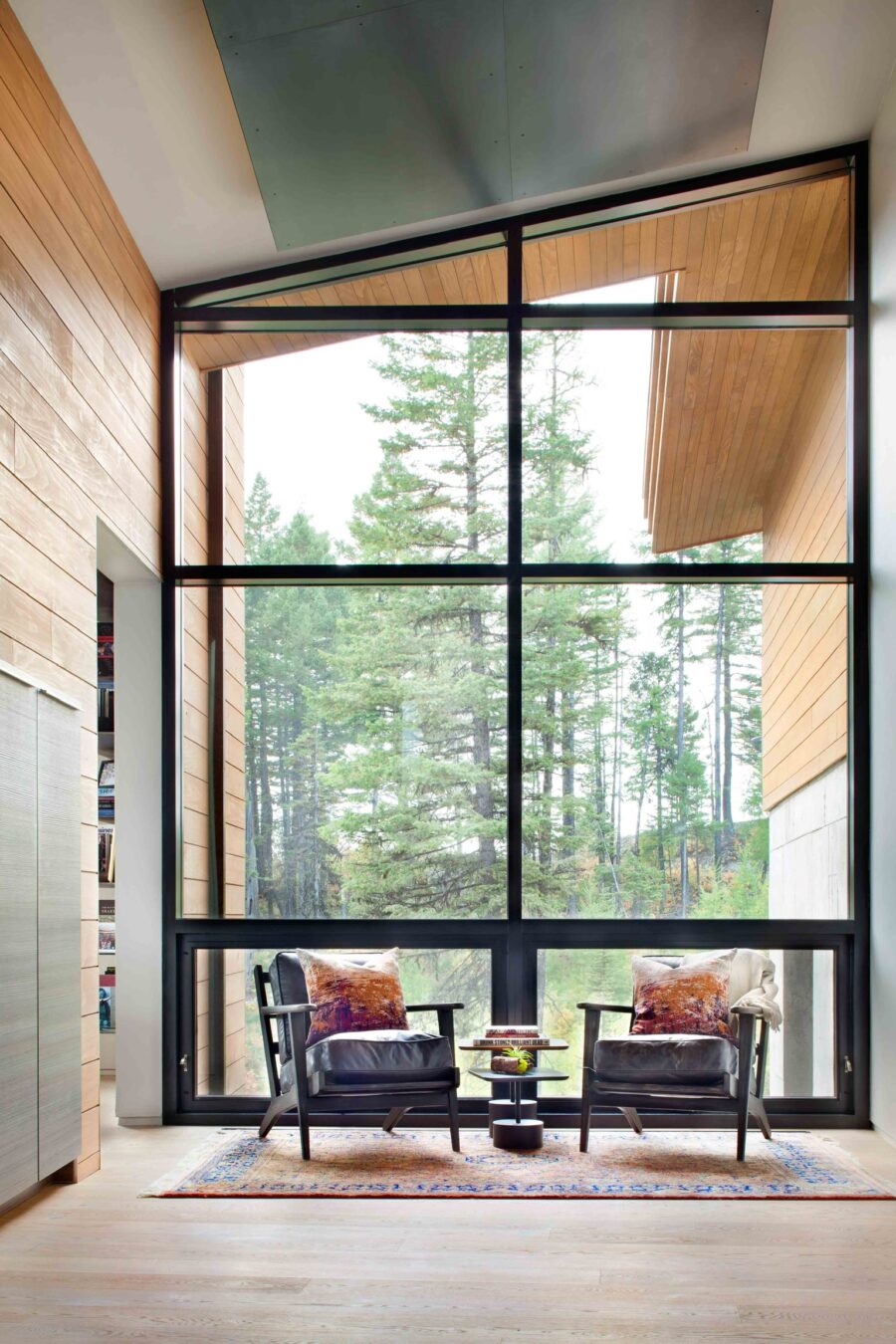
If architecture creates the framework for mountain views, windows provide the critical connection. In Boulder’s view-focused homes, windows transcend basic function to become defining architectural elements that frame, direct, and enhance mountain vistas.
Window Types That Showcase Boulder’s Mountain Panoramas
The evolution of window technology has revolutionized how we experience mountain views in Boulder homes. Today’s options include:
- Floor-to-ceiling windows create uninterrupted visual connections to the mountains, essentially turning entire walls into viewing portals. These dramatic installations work particularly well in main living areas and primary bedrooms where the emotional impact of full-height views can be best appreciated.
- Fixed picture windows provide the clearest, most unobstructed views with maximum glass area and minimal framing. While they don’t open for ventilation, they offer superior energy efficiency and can be combined with operable windows for a balanced approach.
- Sliding glass walls and lift-and-slide doors have transformed how Boulder homeowners connect to mountain views. These systems can open entire walls to the outdoors, creating seamless indoor-outdoor integration that’s particularly valuable during Boulder’s perfect summer evenings and crisp fall days.
- Corner glass installations where glass meets glass with minimal structural interference create panoramic vistas that wrap around the home. These dramatic elements require precise engineering but offer unparalleled viewing experiences, particularly for sites with multi-directional view opportunities.
- Clerestory and transom windows introduce light and glimpses of mountain tops in areas where privacy concerns or furniture placement might otherwise limit view opportunities. These higher installations complement primary view windows while balancing light from multiple directions.
The Transformative Impact of Floor-to-Ceiling Glass
Few architectural elements have transformed Boulder’s view-focused homes as dramatically as floor-to-ceiling glass. By eliminating the traditional window wall in favor of vast expanses of glass, these installations create immersive connections to the mountains that blur the boundary between indoors and outdoors.
Beyond the obvious visual impact, floor-to-ceiling glass offers several specific advantages for mountain view homes:
The absence of horizontal framing elements means nothing interrupts the vertical sweep from ground to sky, allowing viewers to appreciate the mountains’ full grandeur from base to peak. This unbroken visual connection is particularly valuable for appreciating the Flatirons and other dramatic vertical features in Boulder’s landscape.
The psychological effect of full-height glass extends beyond the view itself. These installations flood interiors with natural light, making spaces feel larger and more connected to the rhythms of the day as light changes from morning to evening.
Advancements in glass technology have addressed previous concerns about energy efficiency. Today’s high-performance glazing systems can provide excellent insulation while still offering crystal-clear views, making floor-to-ceiling installations practical even in Boulder’s variable climate.
Modern structural systems allow for minimal framing, with specialized supports that maximize glass and minimize visual interruptions. The result is cleaner sightlines and more immersive connections to the mountains beyond.
Strategic Window Placement for Optimal View Capture
While large windows create dramatic impact, thoughtful placement often proves more important than sheer size. Strategic window positioning considers both the specific views available and how spaces are used throughout the day.
In Boulder’s mountain view homes, window placement often follows these principles:
- Align primary living spaces like great rooms, kitchens, and master bedrooms with the most spectacular views. These are areas where you’ll spend the most time and can best appreciate the changing light on the mountains throughout the day.
- Consider daily routines when positioning view windows. Morning light streaming through east-facing windows while you prepare breakfast, or sunset views from dining areas where you gather for evening meals, creates meaningful daily connections to the landscape.
- Frame specific mountain features rather than trying to capture everything. A carefully positioned window that perfectly frames the Flatirons or focuses on a particular peak often creates more impact than a larger window with a less focused view.
- Layer views throughout the home so that the mountains are revealed gradually as you move through spaces. This creates a journey of discovery rather than revealing everything at once, adding richness to the experience of the home.
- Consider seasonal changes in planning window placement. Windows positioned to capture winter sunlight on snow-covered peaks or frame fall colors may create different but equally valuable experiences throughout the year.
As one Boulder architect explains,
“Window placement is more art than science. We often spend hours on site with clients at different times of day, marking exactly where views appear and how they change with the light. Those observations inform every decision about window size, position, and frame design.”
Interior Design Strategies That Highlight Mountain Views
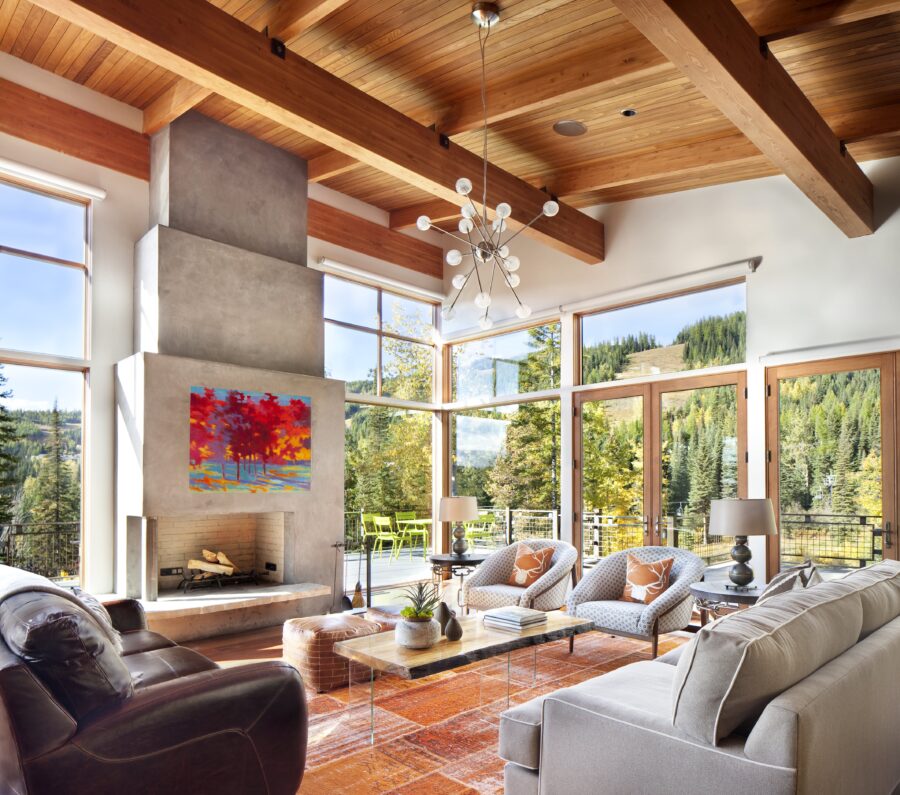
Once architectural and window decisions establish the fundamental view relationships, interior design plays a crucial role in enhancing, complementing, and directing attention to Boulder’s mountain panoramas.
How Interior Layout Affects Mountain View Experience
The arrangement of interior spaces significantly impacts how mountain views are experienced. In Boulder’s view-focused homes, several layout principles have proven particularly effective:
Position the most frequently used spaces to take full advantage of prime views. This means placing living rooms, kitchens, and primary bedrooms where they can benefit from the most spectacular vistas, while relegating utility areas, storage, and secondary spaces to less view-rich parts of the home.
Create a thoughtful hierarchy of views throughout the home. Not every space can have the premier view, but a well-designed home offers a variety of differently framed mountain vistas as you move through it, from dramatic panoramas in public spaces to more intimate framed views in private areas.
Consider circulation patterns that reveal views strategically. Something as simple as positioning a hallway to end with a perfectly framed view of the Flatirons, or designing a staircase that gradually reveals a mountain panorama as you ascend, can create powerful moments of connection to the landscape.
Use changes in ceiling height to emphasize views. Higher ceilings adjacent to major view windows enhance the sense of openness and connection to the outside, while lower ceilings in transition spaces can create compression before release into view-dominated areas.
Balance exposure with protection. While maximum glass might seem ideal for views, the most comfortable spaces typically balance openness with a sense of shelter. Architectural elements that frame views while providing visual anchoring often create more psychologically comfortable spaces than complete exposure.
View-Enhancing Furniture Arrangements
Furniture placement functions as the final layer of view orchestration, directing attention and creating comfortable vantage points for mountain appreciation. Several approaches work particularly well in Boulder’s view-focused homes:
Orient seating to face the views, particularly in primary living spaces. This seemingly obvious principle is sometimes compromised for conversational groupings or television viewing, but the most successful mountain homes make the landscape the star attraction.
Opt for lower-profile furniture that won’t obstruct sightlines, especially pieces positioned between primary living areas and view windows. This doesn’t necessarily mean minimalist furniture—comfortable, substantial pieces can work beautifully as long as their height doesn’t compete with the views.
Choose transparent or visually lightweight elements like glass tables, open-back chairs, or pieces with slender legs that allow views to flow through and around them. These choices maintain functional needs without creating visual barriers.
Create multiple viewing stations throughout the room, recognizing that different times of day, seasons, or weather conditions might make various vantage points more appealing. A window seat for morning coffee, a comfortable reading chair for afternoon light, and a gathering space for sunset appreciation provide options for different moods and moments.
Consider modular or movable furniture that can adapt to changing needs while maintaining view relationships. Pieces that can be easily reconfigured allow spaces to evolve while still prioritizing connection to the mountains.
Using Color and Minimalism to Emphasize Mountain Panoramas
When the goal is to emphasize Boulder’s magnificent mountain views, interior color and material choices play a subtle but crucial supporting role. The most successful view-focused interiors typically follow these principles:
Adopt a relatively restrained color palette that complements rather than competes with the landscape. This doesn’t necessarily mean all-white interiors—warm neutrals, soft earth tones, and muted natural colors often create harmony with mountain views while maintaining interior interest.
Save stronger color accents for areas away from primary view windows, where they won’t distract from the natural panorama. These punctuation points can add personality and visual interest to the home without competing with the views.
Embrace materials that reference the landscape without literally mimicking it. Stone, wood, metal, and glass used in refined ways can create subtle connections to the natural elements visible through the windows without becoming overly rustic or theme-like.
Consider how finishes interact with changing natural light. Matte surfaces typically provide quieter backgrounds for views than highly reflective ones, which might create glare or distracting reflections that compete with the landscape.
Remember that true minimalism isn’t about absence but about purposeful restraint. The goal isn’t to create sterile, empty spaces but rather to carefully curate elements that support rather than distract from the connection to Boulder’s beautiful mountain backdrop.
Landscaping Techniques That Enhance Mountain Views
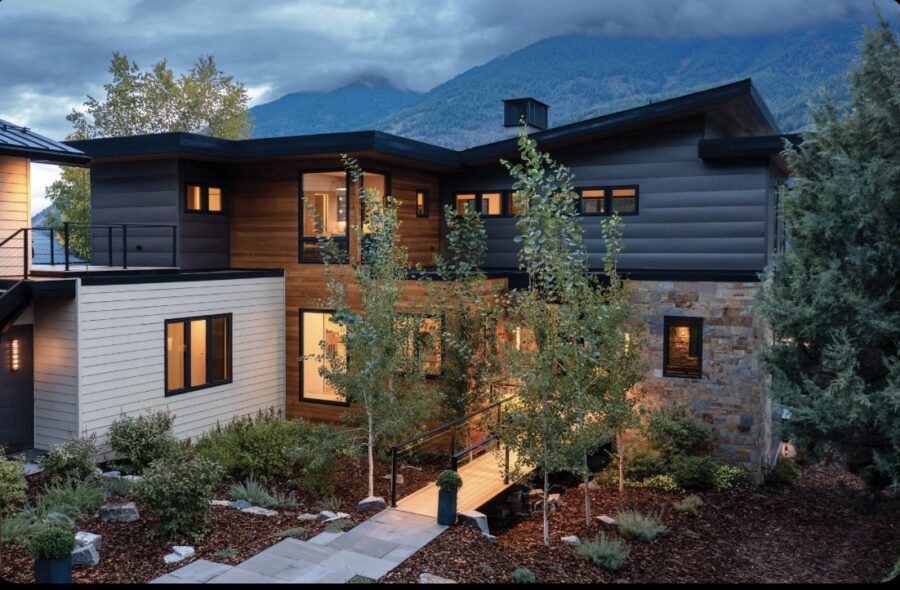
In Boulder’s view-focused homes, the landscape design serves as a crucial transitional zone between architecture and the mountain vistas beyond. Thoughtful landscaping can frame, direct, and enhance views while providing privacy and creating usable outdoor living spaces.
How Strategic Planting Can Frame and Improve Views
Vegetation plays multiple roles in view-focused landscapes, functioning variously as frame, filter, and foreground for mountain panoramas:
Use trees and larger shrubs to frame significant views, positioning them to create natural “windows” that direct attention to specific mountain features. This framing effect can actually enhance views by providing context and contrast for the mountains beyond.
Create layered depth with foreground, middle-ground, and background elements. A thoughtfully designed landscape establishes a visual journey from immediate garden features through middle-distance elements to the mountain backdrop, adding richness and dimension to the view experience.
Consider seasonal changes when selecting plants. Deciduous trees might block summer sun while allowing winter views when their leaves drop, while evergreens provide year-round screening but with consistent view impacts. In Boulder’s climate, this seasonal dynamism can be harnessed to enhance views in different ways throughout the year.
Use vertical elements like columnar trees or architectural features to echo and complement mountain forms visible in the distance. These elements create visual connections between the immediate landscape and the greater geography beyond.
Remember that views change as vegetation matures. What works when plants are young may create unexpected screening once they reach maturity. Working with a landscape designer who understands plant growth patterns and their long-term relationship to views is invaluable.
Using Native Plants to Complement Mountain Vistas
Boulder’s natural ecosystem provides a perfect palette of plants that not only survive the local climate conditions but also create authentic connections to the larger landscape:
Native grasses like blue grama, little bluestem, and fescues require minimal water once established and provide beautiful movement that draws the eye toward mountain views beyond. Their seasonal color changes—from spring green to summer gold to winter amber—add dynamic interest that complements the mountain backdrop.
Indigenous shrubs such as mountain mahogany, Apache plume, and serviceberry offer structure and seasonal interest while requiring minimal maintenance. These plants have evolved to thrive in Boulder’s specific conditions and create natural harmony with the visible landscape beyond.
Strategic placement of signature local species like ponderosa pines can create powerful visual connections between your immediate surroundings and the forested mountain slopes visible in the distance. These ecological echoes strengthen the sense of place and belonging in the larger landscape.
Ground covers and perennials inspired by Boulder’s native meadows can create foreground interest that complements rather than competes with mountain views. Plants like sulphur flower, blanket flower, and Rocky Mountain penstemon add seasonal color while maintaining visual compatibility with the natural landscape.
Beyond aesthetics, native plants offer practical advantages: they typically require less water, fertilizer, and maintenance than non-native alternatives, and they support local pollinators and wildlife, enhancing the ecological value of your property.
Avoiding Common Landscaping Pitfalls in View-Focused Properties
Several common landscaping mistakes can compromise Boulder’s mountain views. Awareness of these potential pitfalls helps ensure your landscape enhances rather than detracts from view enjoyment:
Avoid placing trees that will eventually grow tall directly in prime view corridors. Even slow-growing species eventually mature, and what seems like a modest tree at planting can become a significant view obstruction over time.
Be cautious with evergreen hedges and screens, which provide year-round privacy but also create year-round view blockage. Consider more selective screening with deciduous plants or architectural elements that block specific sightlines while preserving mountain views.
Remember that both your views and your neighbors’ matter. Thoughtless placement of tall vegetation can significantly impact nearby properties’ view enjoyment, potentially creating tension and even legal issues in view-sensitive areas.
Don’t overplant near the house, particularly adjacent to view windows. Plants that look appropriately scaled at installation can quickly grow to block sightlines. Maintain adequate distance between major view windows and plantings that might eventually obstruct them.
Consider how irrigation and maintenance requirements align with view preservation. Complex plantings that demand frequent attention can become neglected over time, leading to overgrowth that gradually diminishes views.
Creating Outdoor Living Spaces That Maximize Mountain Views
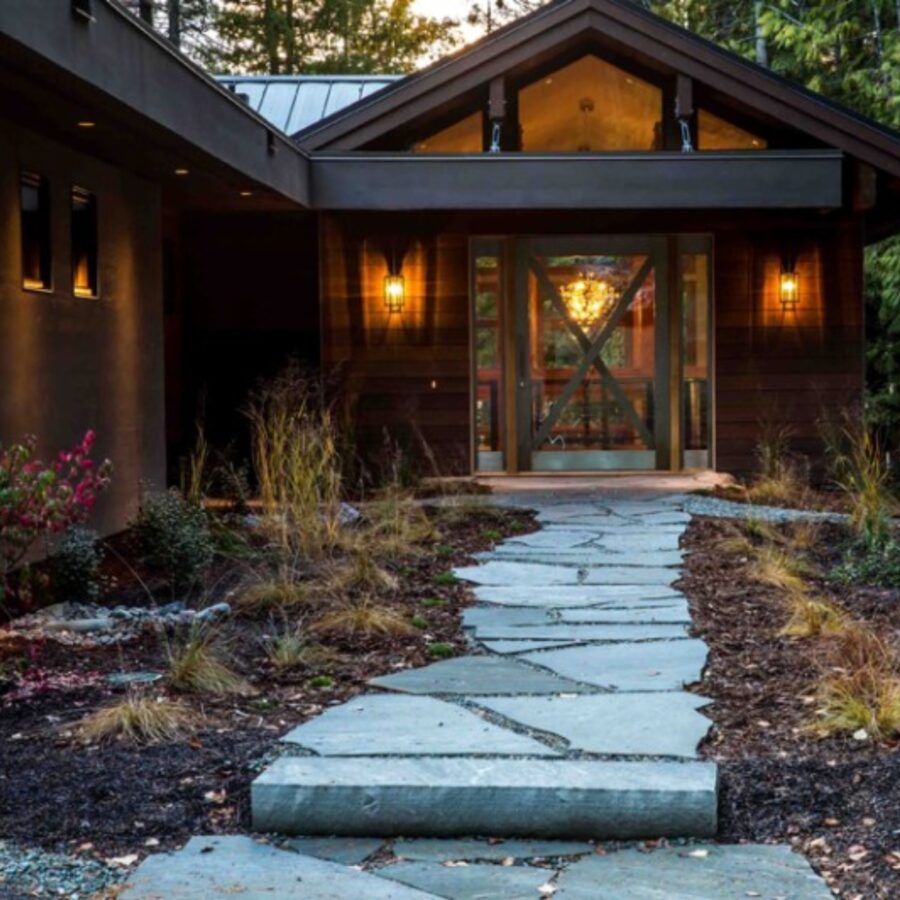
Boulder’s climate, with its 300+ annual days of sunshine and generally mild temperatures, makes outdoor living a natural extension of the home. When designed thoughtfully, these spaces create new vantage points for mountain appreciation while expanding functional living area.
Outdoor Features That Enhance Mountain View Enjoyment
Several specific outdoor elements have proven particularly valuable for optimizing mountain view enjoyment in Boulder homes:
Elevated decks provide superior vantage points for unobstructed views, especially on sloped sites or in neighborhoods where fence lines might otherwise limit ground-level perspectives. Multi-level decks can create different viewing experiences and accommodate various activities while maintaining visual connections to the mountains.
Covered patios extend the seasons for outdoor enjoyment, offering protection from Boulder’s intense summer sun and occasional precipitation while framing views of the landscape beyond. These transitional spaces bridge indoor and outdoor living while providing comfortable vantage points in variable weather conditions.
Outdoor kitchens and dining areas oriented toward prime views transform meal preparation and enjoyment into opportunities for mountain appreciation. Social gatherings naturally focus outward when spectacular vistas form the backdrop for outdoor entertaining.
Fire features extend evening enjoyment of mountain views, creating warm, inviting gathering spaces that remain comfortable even as temperatures drop after sunset. The contrast between the intimate fire circle and the vast mountain panorama creates a particularly powerful experiential juxtaposition.
Hot tubs and plunge pools positioned to face mountain views offer immersive relaxation experiences enhanced by natural beauty. Few pleasures match soaking in warm water while gazing at moonlit peaks or watching changing light paint the Flatirons at sunset.
Benefits of Elevated Decks and Terraces for View Optimization
While ground-level patios offer certain advantages, elevated outdoor spaces provide several specific benefits for mountain view enjoyment:
Height overcomes immediate visual obstacles like neighboring buildings, fences, or vegetation that might obstruct views from ground level. Even a modest elevation gain can significantly expand the visible landscape, revealing mountain vistas that might otherwise remain hidden.
Multiple levels create different viewing experiences and functional zones while maintaining visual connections to the mountains. A terraced approach might feature an upper deck for dining with panoramic views, a mid-level lounge area with a more focused perspective, and ground-level access to the garden landscape.
Structural supports for elevated decks can be designed to minimize visual interference, using slender columns, steel cables, or cantilevered construction that preserves clear sightlines to the mountains. These architectural solutions create the sensation of floating in the landscape rather than being firmly anchored to it.
Railings deserve particular attention in view-focused decks. Glass panels, horizontal cables, or minimalist metal elements preserve views while meeting safety requirements. The choice of railing system significantly impacts the visual experience from seated positions, where solid elements might block crucial sightlines.
Weather considerations influence elevated deck design in Boulder’s climate. Thoughtful orientation, partial covering, wind screens, and sun shading can significantly extend seasonal usage while maintaining prime viewing opportunities throughout the year.
Creating Seamless Transitions Between Indoor and Outdoor View Spaces
The most successful view-focused homes in Boulder blur the distinction between interior and exterior, creating a continuous experience of the mountain landscape from multiple vantage points:
Consistent flooring materials that extend from inside to outside reinforce the sense of a single expanded living space. Options like stone, concrete, or compatible wood and composite decking can create visual continuity while meeting the different performance requirements of interior and exterior environments.
Retractable glass walls essentially eliminate the barrier between indoors and outdoors when weather permits. These sophisticated systems allow living spaces to completely open to mountain views and fresh air while providing security and weather protection when closed.
Aligned ceiling planes that continue from interior spaces to covered outdoor areas enhance the sense of spatial continuity. This architectural synchronization guides the eye outward toward the views while providing weather protection that extends outdoor usage seasons.
Coordinated lighting for evening view enjoyment requires careful consideration. Excessive or poorly placed outdoor lighting can create reflections on glass that obscure nighttime views, while thoughtfully positioned, low-level illumination can enhance evening outdoor experiences without competing with moonlit mountain vistas.
Climate considerations influence how seamlessly indoor-outdoor connections can function throughout Boulder’s seasons. Elements like overhead heaters, wind screens, and retractable shades expand the comfortable usage period for outdoor view spaces despite seasonal temperature variations.
Sustainable Materials and Practices for Boulder Mountain Homes
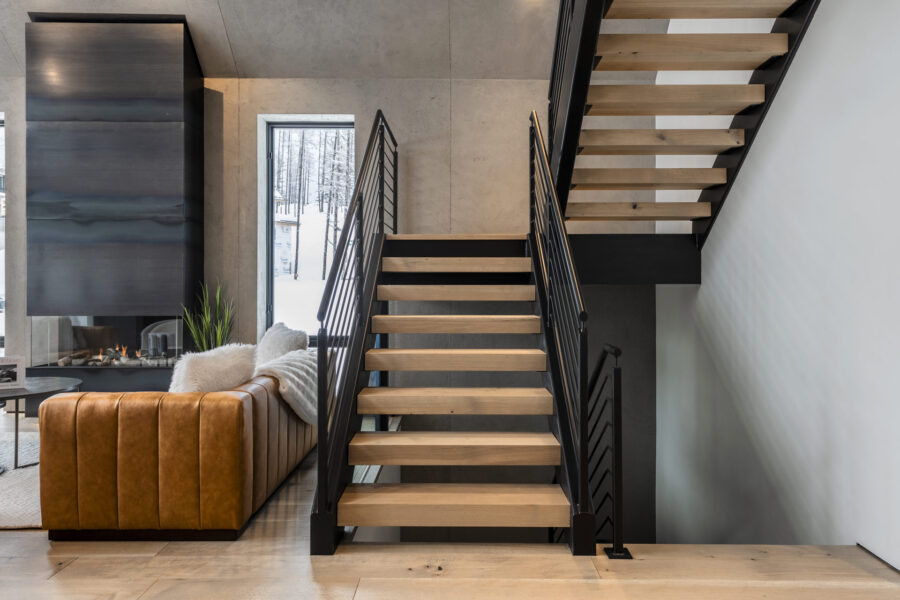
Boulder’s community values emphasize environmental stewardship alongside aesthetic considerations. The most admired view-focused homes integrate sustainability principles that complement rather than compromise the connection to the mountain landscape.
Natural Materials That Harmonize with Mountain Settings
Certain materials create particular resonance with Boulder’s mountain environment while offering environmental benefits:
Locally Sourced Stone
Locally sourced stone provides visual and literal connection to the geological context of the Front Range. Whether used for walls, floors, fireplace surrounds, or landscape elements, native stone grounds architecture in place while minimizing transportation impacts and supporting local extraction economies.
Sustainably Harvested or Reclaimed Wood
Sustainably harvested or reclaimed wood brings warmth and natural character that complements mountain views rather than competing with them. Boulder’s design community increasingly emphasizes responsible sourcing, with preference for FSC-certified products, beetle-kill pine that addresses forest health challenges, or reclaimed timbers that combine history with environmental benefits.
Corten and Weathering Steel
Corten and weathering steel develop rich, variable patinas that reference the iron-rich coloration of Boulder’s soil and rock formations. These durable, low-maintenance materials age gracefully in the landscape while requiring minimal resources for upkeep over their long lifespan.
Natural Plasters and Earth-Based Finishes
Natural plasters and earth-based finishes derived from local soils create subtle, light-responsive surfaces that change character throughout the day as mountain light shifts across them. These materials offer exceptional aesthetic qualities while typically containing minimal embodied energy and few or no toxic components.
Advanced Glass Technologies
Advances in glass technology have made expansive view windows more environmentally responsible than ever before. High-performance glazing with multiple layers, specialized coatings, and inert gas fills can provide both excellent views and superior energy performance, reducing the historical tradeoff between view maximization and thermal efficiency.
Integrating Sustainable Practices with View-Focused Design
Beyond material selection, several design approaches allow Boulder’s mountain view homes to minimize environmental impact while maximizing connection to the landscape:
- Passive solar orientation typically aligns perfectly with view optimization in Boulder, where southern exposures often provide both excellent winter solar gain and dramatic mountain vistas. This fortunate coincidence allows homes to reduce energy consumption while enhancing view enjoyment.
- Strategic overhangs and shading elements protect interiors from excessive solar gain during summer months while preserving views and allowing beneficial winter sun penetration. These architectural features can be designed as elegant complements to the overall composition rather than utilitarian additions.
- High-performance building envelopes with superior insulation, air sealing, and thermal break technologies allow for generous glazing without excessive energy penalties. This approach permits larger view windows while still maintaining excellent overall energy performance.
- Water-conscious landscaping using native and adapted species reduces resource consumption while creating visual harmony with the visible natural landscape beyond the property boundaries. Boulder’s water conservation ethics align perfectly with landscapes that complement rather than contrast with the mountain views.
- Renewable energy systems, particularly rooftop solar, can be integrated thoughtfully into view-oriented designs. While panel placement requires careful consideration to avoid compromising either energy production or view corridors, skilled designers increasingly find solutions that satisfy both imperatives.
As Robert Gilbert of Stillwater Architecture observes,
“The most successful view homes in Boulder don’t treat sustainability as a separate consideration—they recognize that deep connection to place inherently involves environmental responsibility.”
Overcoming Common Challenges in View-Focused Boulder Homes
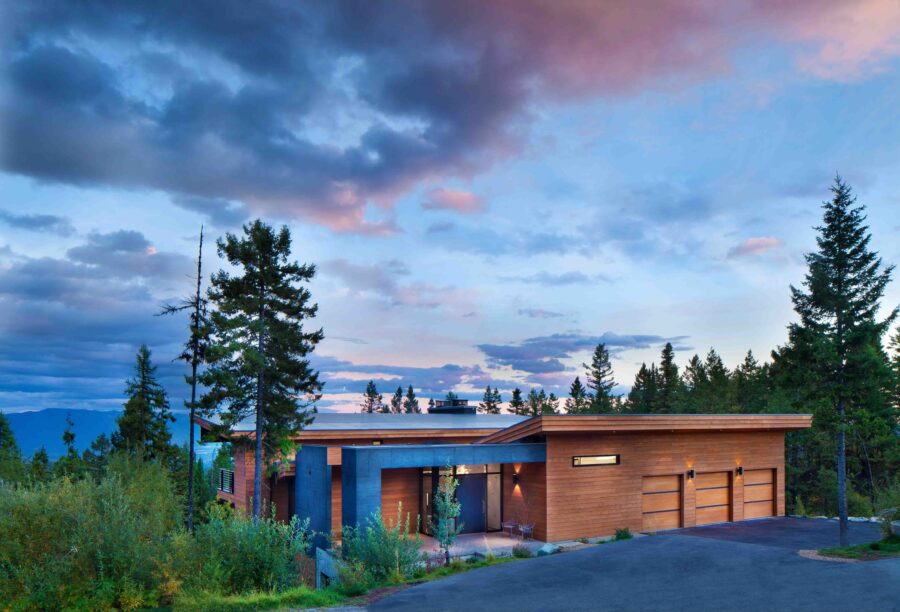
Even with ideal sites and thoughtful design, certain challenges consistently arise in Boulder’s view-focused homes. Recognizing and addressing these issues early in the design process leads to more successful outcomes.
Navigating Terrain Challenges for Optimal View Capture
Boulder’s dramatic topography creates both opportunities and complications for view-focused design:
Sloped sites offer natural elevation advantages for views but present construction complexities. Stepped foundations, split-level designs, and thoughtful grading can work with rather than against challenging topography to maximize view potential while minimizing site disturbance.
Rocky terrain, common throughout Boulder, complicates excavation and foundation work but often provides natural elevation changes that enhance viewing opportunities. Working with geology rather than fighting it typically yields more organic integration with the landscape.
Drainage considerations become particularly important on sloped sites where water management affects both structural integrity and landscape health. Well-designed systems direct water away from foundations while supporting vegetation that complements view corridors.
Access challenges on steep properties require careful planning to create functional approaches that don’t compromise views or require excessive grading. Thoughtful driveway design can actually enhance arrival sequences, gradually revealing mountain panoramas as you approach the home.
Erosion control on sloped sites demands ongoing attention, particularly in Boulder’s climate where intense summer thunderstorms can cause significant water movement. Stabilization strategies that employ native plants often prove most effective while enhancing rather than detracting from the natural aesthetics that complement mountain views.
Avoiding Common Mistakes in Mountain View Optimization
Several pitfalls consistently challenge even experienced designers working on mountain view homes in Boulder. Being aware of these common mistakes can help you avoid costly errors:
Poor site orientation is perhaps the most fundamental error. I’ve seen beautiful homes with extensive glazing positioned in ways that completely miss the best mountain views. Before finalizing any design, spend time on your property at different times of day to understand exactly where the most compelling vistas appear. This simple step can fundamentally improve your relationship with the landscape.
Insufficient sun management often undermines view enjoyment. Large windows without proper overhangs or shading can create unbearable glare and overheating, particularly in Boulder’s intense high-altitude sunlight. I remember visiting one stunning home where the owners had installed expensive blackout shades that they kept closed most daylight hours because the glare made their great room unusually comfortable. What a missed opportunity!
Over-landscaping is surprisingly common, particularly as properties mature. What begins as thoughtfully placed vegetation often grows to gradually obscure once-pristine views. Creating a long-term landscape management plan with view preservation as a priority helps maintain your visual connection to the mountains for years to come.
Prioritizing views at the expense of privacy sometimes leads to uncomfortable living situations. Finding the right balance between openness to the landscape and protection from neighboring sightlines requires careful consideration. Strategic placement of architectural elements, selective screening, and thoughtful interior layouts can address both needs without compromise.
Neglecting nighttime view experiences limits enjoyment of Boulder’s spectacular dark skies and moonlit mountain silhouettes. Poorly planned interior lighting creates reflections on view windows that effectively turn them into mirrors after dark. Careful lighting design with dimmable fixtures, well-placed exterior illumination, and thoughtful control systems maximizes 24-hour view appreciation.
I’ve also witnessed the frustration that comes from failing to anticipate neighboring development. Even in Boulder’s relatively controlled building environment, new construction, growing trees, or additions on adjacent properties can significantly impact established views. Understanding local regulations, easements, and development patterns helps protect your visual investment over time.
Weather Considerations for Boulder Mountain View Homes
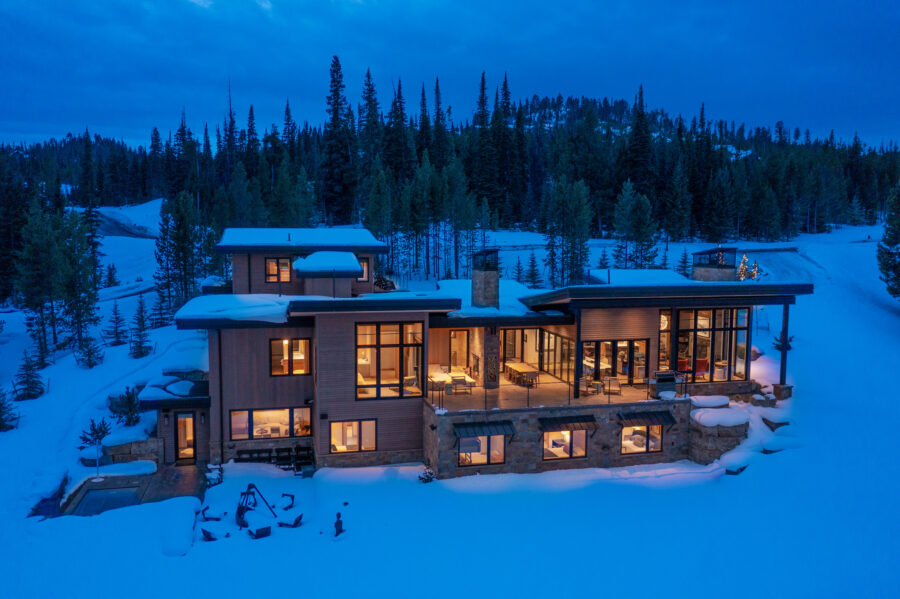
Boulder’s climate presents specific challenges and opportunities for homes designed to maximize mountain views. Understanding and working with these conditions creates more successful, comfortable spaces for year-round view enjoyment.
Designing for Boulder’s Intense Sunlight
At over 5,400 feet elevation with more than 300 sunny days annually, Boulder’s sunlight is remarkably intense. This abundant sunshine enhances mountain views with dramatic lighting but requires thoughtful management:
High-performance glazing with appropriate solar heat gain coefficients helps control heat while maintaining view clarity. The latest glass technologies offer excellent visible light transmission while reflecting thermal energy that would otherwise overheat interiors.
Strategic overhangs and exterior shading elements block high summer sun while admitting lower winter sunlight—a perfect complement to passive solar design principles that work wonderfully with view-oriented architecture in Boulder’s climate.
Interior shading systems provide additional control when needed. Motorized blinds or shades that disappear completely when not in use protect from occasional glare without permanently obstructing views. The best systems can be programmed to respond automatically to changing sun positions throughout the day and year.
Thoughtful orientation balances view priorities with solar management. While western exposures offer dramatic afternoon light on the mountains, they also receive the most intense solar heat gain. Sometimes slightly adjusting view angles can maintain mountain vistas while substantially improving comfort.
Special consideration for reflected light from snow is important for winter comfort. The combination of direct sunlight and snow reflection can create exceptionally bright conditions that may require additional shading flexibility during winter months when the sun’s path is lower in the sky.
Managing Wind Exposure in View-Focused Spaces
Boulder’s location along the Front Range creates significant wind exposure, particularly during winter and early spring when powerful Chinook winds can gust over 100 mph. These conditions demand attention for view-oriented features:
Structural engineering for large windows, elevated decks, and other view-oriented elements must account for these exceptional wind loads. Proper reinforcement and connections ensure both safety and long-term performance.
Strategic windbreaks can protect outdoor viewing areas without obstructing sightlines. These might include architectural elements, carefully positioned plantings, or topographical features that deflect rather than block wind flow.
Operable window systems allow natural ventilation during pleasant conditions while providing secure closure during high-wind events. The best systems offer multiple operational modes to adapt to Boulder’s variable conditions throughout the year.
Outdoor furnishings for view decks and terraces should be selected with wind exposure in mind. Heavy, substantial pieces, secure anchoring systems, or storage options for extreme conditions prevent damage and danger during high-wind episodes.
Noise considerations become relevant in high-wind areas, as a large glass expanse can create resonance or whistling sounds under certain conditions. Proper installation details, appropriate glass thickness, and acoustic treatments can help manage these effects.
Conclusion: Creating Your Perfect Boulder Mountain View Home
Designing a home that truly maximizes Boulder’s spectacular mountain views requires thoughtful integration of site selection, architectural approach, window design, interior choices, and landscape decisions. Each element contributes to the overall experience of connection with Boulder’s extraordinary natural setting.
The most successful mountain view homes in Boulder share certain qualities regardless of their specific architectural style or size. They respond authentically to their sites, framing and enhancing views rather than forcing predetermined design ideas. They balance openness with comfort, creating spaces that feel both expansive and intimate. And they evolve with the seasons, offering different but equally compelling relationships with the mountains throughout the year.
As you consider your own Boulder mountain view project, remember that the goal isn’t simply to create picture windows—it’s to foster a deeply meaningful connection with this remarkable landscape that enhances your daily experience of home. The mountains aren’t just something to look at; they become part of your living environment, changing with the light, seasons, and weather in ways that continually refresh your visual experience.
Whether you’re planning a new build, a significant renovation, or simply looking to enhance your existing home’s relationship with Boulder’s mountain backdrop, thoughtful attention to the principles we’ve explored can dramatically improve both your enjoyment and your property’s value. The modest additional investment in view-optimizing design typically returns many times over in both quality of life and financial appreciation.
In the words of one satisfied Boulder homeowner whose thoughtfully designed mountain view home I recently visited:
“We never tire of the view. Even after five years, we still stop what we’re doing sometimes just to watch the changing light on the Flatirons. It’s like living with a constantly evolving work of art.”
And isn’t that exactly what a Boulder mountain view home should provide?
About Stillwater Architecture
 Founded in 2003 by Robert L. Gilbert and Michael Donohue, Stillwater Architecture is a premier residential design firm with expertise in custom, high-end homes. Their projects span numerous states, including Montana, Illinois, and Colorado, with a focus on creating personalized, timeless residences that resonate with each client’s lifestyle and tastes.
Founded in 2003 by Robert L. Gilbert and Michael Donohue, Stillwater Architecture is a premier residential design firm with expertise in custom, high-end homes. Their projects span numerous states, including Montana, Illinois, and Colorado, with a focus on creating personalized, timeless residences that resonate with each client’s lifestyle and tastes.
-
Michael Donohue is an NCARB-certified architect with over 35 years of experience designing custom homes in mountain towns and resort communities. He co-founded Stillwater Architecture, where he’s built a reputation for creating thoughtful, client-driven designs. To connect with Michael Donohue and explore how his expertise can bring your vision to life, visit his contact page.